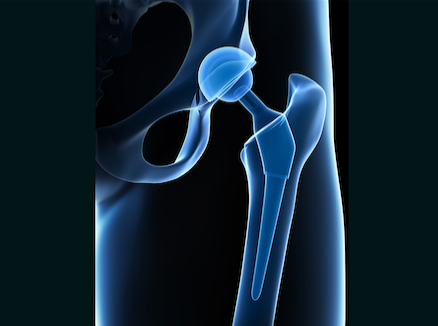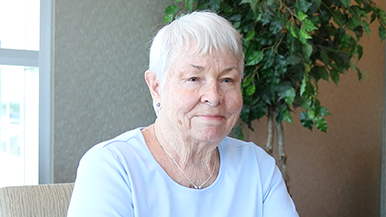When debilitating joint pain becomes a reality of daily life, it can gravely affect one’s sense of feeling alive. Just ask Yvonne.
The chronic pain in her hip made getting into the bathtub, bending over or even tying her shoes a living nightmare. She was unable to stand for a few minutes at a time without excruciating discomfort.
That all changed after Yvonne consulted with James D. Hoffman, M.D., F.A.A.O.S., a board certified orthopaedic surgeon at South Florida Orthopaedics & Sports Medicine. Dr. Hoffman recommended a full hip replacement to give Yvonne the best chance of returning to a normal life.
“The results were amazing, just amazing. I feel like I’m ten years younger,” says Yvonne. “I plan to go back to scuba diving in the summer.”
Struggling With Chronic Pain
Yvonne suffered for years from chronic and exacerbating pain. When pain medication proved ineffective, and as she got weaker, Yvonne finally decided she needed to do something about it.
“I’d suffered for a couple of years with steadily worsening pain,” says Yvonne. “I was taking too many ibuprofen and too many painkillers. Finally, I decided I had to go in and see what was wrong with me.”
After an extensive x-ray analysis, Dr. Hoffman recommended a full left hip replacement. “Dr. Hoffman was very understanding, and he wasn’t pushy,” says Yvonne. “He didn’t act like he was going to force me into doing the operation. It was strictly my decision.”
Yvonne was scared and hesitant to move forward with surgery, but when all was said and done, she realized that Dr. Hoffman’s advice was the right thing to do. “Dr. Hoffman recommended it, and I finally realized that he was right,” says Yvonne. “I’m like the ostrich. I was in denial for about a week, and then I said ‘I’ve got to get this done.’”
What Happens During a Total Hip Replacement?

In a healthy hip joint, tendons, ligaments, and muscles stabilize the bones. Thanks to cartilage and synovial fluid that surrounds the bones, they can glide smoothly over one another. However, wear and tear over time can weaken the smooth functioning of the hip joint and erode the precious and fragile protective tissues and substances that protect it. As a result, patients can experience persistent pain and a significant loss of mobility.
Total hip replacement, also known as hip arthroplasty, aims to replace a damaged hip with prosthetic components to reduce hip pain and improve hip function. The process may involve:
- Removing the injured bone and cartilage
- Replacing the head of the femur (thigh bone) with a metal or ceramic stem and ball
- Taking out defective cartilage from the hip socket (acetabulum) and replacing it with a metal socket (screws may be inserted to stabilize the cavity)
- Placing an artificial spacer between the new ball and the socket to enable them to glide smoothly over each other
Since it was first performed almost sixty years ago, hip replacement surgery is one of the most successful operations performed in the United States. More than 300,000 total hip replacements are done every year with the majority of those patients being over 75-years-old. About 1% of American adults, or 2.5 million people, live with an artificial hip.
“Before the surgery, I was unable to climb into the bathtub,” says Yvonne. “I couldn’t tie my shoes or bend over. If I got down on the floor, I couldn’t get up. And I was slowly getting weaker because I couldn’t exercise. I was unable to stand for more than a few minutes because of the pain. “Now I can do all of those things,” says Yvonne.
Results Following Hip Replacement Surgery
 Each patient’s recovery time will be influenced by their lifestyle, medical and family history, and how closely they follow their doctor’s home-care instructions following surgery. Light exercise and physical therapy play a critical part in the rehabilitation process in the first few weeks after the procedure.
Each patient’s recovery time will be influenced by their lifestyle, medical and family history, and how closely they follow their doctor’s home-care instructions following surgery. Light exercise and physical therapy play a critical part in the rehabilitation process in the first few weeks after the procedure.
Following her surgery, Yvonne recovered for a couple of days in the hospital and then underwent two weeks of physical therapy to help speed up her recovery. “The operation was done, I spent two days in the hospital, and I was out,” says Yvonne. “Two weeks of therapy and I’m amazed at how wonderful I feel. I really feel great.”
“Dr. Hoffman has a wonderful support group of therapists located right in the building. Everybody was just so helpful and pleasant. It was a good place to be. And I’ve recommended Dr. Hoffman to others as well.”
After her successful hip replacement surgery, Yvonne wishes for others to be able to experience the same benefits as her. “People need to realize that it’s not going to get better by itself,” she says. “It has to be helped by a good surgeon who knows what he’s doing, and Dr. Hoffman has had plenty of experience doing these operations. Don’t wait. The longer you wait, the worse it gets.”
